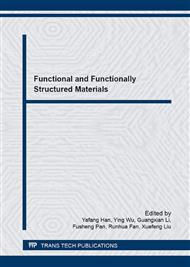[1]
A. Sidorenko, T, Krupenkin, A. Taylor, et al. Reversible switching of hydrogel-actuated nanostructures into complex micropatterns. Science 315 (2007), 487–490.
DOI: 10.1126/science.1135516
Google Scholar
[2]
Y. Takashima, S. Hatanaka, M. Otsubo, et al. Expansion-contraction of photoresponsive artificial muscle regulated by host-guest interactions. Nat. Commun. 3 (2012), 1270.
DOI: 10.1038/ncomms2280
Google Scholar
[3]
D. Seliktar, Designing cell-compatible hydrogels for biomedical applications. Science 336 (2012), 1124–1128.
DOI: 10.1126/science.1214804
Google Scholar
[4]
M. A. Stuart, W. T. S. Huck, J. Genzer, et al. Emerging applications of stimuli-responsive polymer materials. Nat. Mater. 9 (2010), 101–113.
Google Scholar
[5]
L. Liu, W. Wang, X. J. Ju, et al. Smart thermo-triggered squirting capsules for nanoparticle delivery. Soft Matter 6 (2010), 3759–3763.
DOI: 10.1039/c002231d
Google Scholar
[6]
J. Q. Liu, C. F. Chen, H. L. Wang, et al. Synthesis of graphene peroxide and its application in fabricating super extensible and highly resilient nanocomposite hydrogels. Acs Nano 6 (2012), 8194-8202.
DOI: 10.1021/nn302874v
Google Scholar
[7]
R. Q. Liu, S. M. Liang, X. Z. Tang, et al. Tough and highly stretchable grapheme oxide/polyacrylamide nanocomposite hydrogels. J. Mater. Chem. 22 (2012), 14160-14167.
DOI: 10.1039/c2jm32541a
Google Scholar
[8]
J. C. Fan, Z. X. S, J. Y, et al. Mechanically strong graphene oxide/sodium alginate/polyacrylamide nanocomposite hydrogel with improved dye adsorption capacity. J. Mater. Chem. A. 1 (2013), 7433-7443.
DOI: 10.1039/c3ta10639j
Google Scholar
[9]
T. Fyjigaya, T. Morimoto, Y. Niidome, et al. NIR Laser-Driven Reversible Volume Phase Transition of Single-Walled Carbon Nanotube/Poly(N-isopropylacrylamide) Composite Gels. Adv. Mater. 20 (2008), 3610-3614.
DOI: 10.1002/adma.200800494
Google Scholar
[10]
Y. T. Wu, Z. Zhou, M. F. Zhu, Facile in-situ fabrication of novel organic nanoparticle hydrogels with excellent mechanical properties. J. Mater. Chem. 19 (2009), 7340-7346.
DOI: 10.1039/b909125d
Google Scholar
[11]
W. J. Chuang, W. Y. Chiu, H. J. Tai. Temperature-dependent conductive composites: poly(N-isopropylacrylamideco-N-methylol acrylamide) and carbon black composite films. J. Mater. Chem. 22 (2012), 20311-20318.
DOI: 10.1039/c2jm33601d
Google Scholar
[12]
L. W. Xia, X. J. Ju, L. Y. Chu, et al. Responsive hydrogels with poly(N-isopropylacrylamide-co-acrylic acid) colloidal spheres as building blocks. Journal of Colloid and Interface Science. 349 (2010), 106-113.
DOI: 10.1016/j.jcis.2010.05.070
Google Scholar
[13]
L. W. Xia, R. Xie, L. Y. Chu, et al. Nano-structured smart hydrogels with rapid response and high elasticity. Nature communications. 4 (2013), 2226-2236.
DOI: 10.1038/ncomms3226
Google Scholar
[14]
H. Lee, S. M. Dellatore, P. B. Messersmith, et al. Mussel-inspired surface chemistry for multifunctional coatings. Science 318 (2007), 426-430.
DOI: 10.1126/science.1147241
Google Scholar
[15]
I. F. Nata, T. M. Wu, C. K. Lee, et al. A chitin nanofibril reinforced multifunctional monolith poly(vinyl alcohol) cryogel. J. Mater. Chem. B, 2 (2014), 4018. -4113.
DOI: 10.1039/c4tb00175c
Google Scholar
[16]
K. Y. Ju, Y. Lee, S. et al. Bioinspired polymerization of dopamine to generate melanin-like nanoparticles having an excellent free-radical-scavenging property. Biomacromolecules, 12 (2011), 625–632.
DOI: 10.1021/bm101281b
Google Scholar
[17]
K. L. Ai, Y. L. Liu, G. Q. Lu, Sp2 C-dominant N-doped Carbon Sub-micrometer Spheres with a Tunable Size: A Versatile Platform for Highly Efficient Oxygen-Reduction Catalysts. Adv. Mater., 2013, 25, 998–1003.
DOI: 10.1002/adma.201203923
Google Scholar
[18]
J. Yan, L. P. Yang, M. F. Lin, et al. Polydopamine spheres as active templates for convenient synthesis of various nanostructures. Small, 9 (2013), 596-603.
DOI: 10.1002/smll.201201064
Google Scholar
[19]
S. Q. Xiong, Y. Wang, Z. M. Hu, et al. Polydopamine particles for next-generation multifunctional biocomposites. J. Mater. Chem. A, 2 (2014), 7578-7587.
DOI: 10.1039/c4ta00235k
Google Scholar


